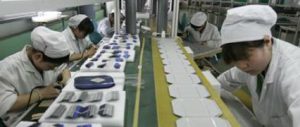Climate change was all but ignored by US President Barack Obama and his Republican rival Mitt Romney during the presidential campaign. So environmentalists were heartened, if not thrilled, when Obama declared at his inauguration a call to action on climate change and clean technology: “We must lead it. We cannot cede to other nations the technology that will power new jobs and new industries.”
But where does the US currently stand in clean energy compared to the unspoken competitor in Obama’s speech — China? And what more can the US do to lead in renewables?
In terms of production and installation of renewable energy resources, the US actually lags behind China. This worries some experts who argue that it is critical for the country to recapture the manufacturing lead.
Read also: A darker side to China’s clean tech
It may still lead on innovation in renewables, but even that is in danger of slipping, according to a recent report on clean tech by the Pew Charitable Trust. It says the US is not among the top 10 countries in investment growth rate over the past five years and ranks 10th in the world in its installed clean energy capacity growth rate since 2006.
It is also ranked just eighth among the G-20 nations in terms of investment intensity, which compares clean energy investments with national economic output.
Take wind power. In just a few years, China has outpaced all other countries in installations. For four years in a row China has overtaken the United States in wind energy, according to a February report by Bloomberg New Energy Finance. At this rate, China is set to beat its goal of installing 100 gigawatts of wind power by 2015 by a year. (Reality check: About 20-25% of China’s capacity isn’t hooked up to the grid mainly because grid construction hasn’t kept up with wind installations and also due to technical issues, says Tom Pellman, an analyst in Vestas’ Beijing office.)
China’s great leap
So how did China leapfrog to become a world leader in wind (and solar)? The central government set important national goals to jumpstart the industry: It established targets to reduce its carbon intensity — that’s the amount of energy used to produce a unit of GDP — and targets for solar and wind power installations. Central and local governments have supported renewables through a variety of subsidies.
In contrast, “US energy policy lacks a clear sense of purpose or direction,” says the Pew report.
In wind power, the lack of consistent, long-term support by the federal government hampers growth, says Pellman. Wind companies laid off hundreds of workers last year when it became uncertain whether Congress would renew a critical one-year tax credit. Congress did extend the tax subsidy under the fiscal cliff deal, but just for one more year. Now the US wind industry is pressing for a five-year extension of the credit.
Another problem for US cleantech companies: venture capital has tightened considerably. Last year, global investment in cleantech dropped to US$6.5 billion, a 33% decline, according to Cleantech Group research. Cleantech has proved to be much more capital intensive than investors anticipated. Seeking faster returns, they’re betting instead on internet-related companies.
As such, when Chinese companies come calling with money to tap US innovation, cash-strapped American cleantech firms welcome the opportunity. Case in point: Wanxiang’s winning bid of US$257 million to purchase the Boston-based car battery maker A123.
Chinese cleantech companies have seen venture capital fall off too, however, the central government is indirectly shoring them up. For instance, in February, in the wake of off-the-charts smog in Beijing and elsewhere, China announced a new national target for solar installations, catapulting it from 21 gigawatts to 35 gigawatts by 2015.
One area where the US is still the envy of China is innovation. “US is certainly the hub for innovative technology,” says Chivas Lam, a partner in Qiming Capital in Shanghai. But numerous expert panels say the US should spend two to four times more on energy R&D over its 2012 level of US$4.36 billion.
At the same time, “China is in fact investing in and succeeding in green innovation…[which] could play a crucial role in the global transition to a low-carbon economy,” writes Joanna Lewis, an assistant professor at Georgetown University, who examines China’s wind industry in her new book, Green Innovation in China.
Innovation battle
China’s progress in innovation is fostered, in part, by a variety of collaborative programmes between the two countries. Lawrence Berkeley National Laboratory has a longstanding partnership with Chinese researchers to improve energy efficiency. The San Francisco-based China Sustainable Energy Program, part of the Energy Foundation, supports Chinese research in many areas.
But for US companies, protecting intellectual property and other assets is a major and very real concern. An expert at a major US company said in an interview that he was about to give his Chinese counterparts a tour of a south-eastern utility’s distribution centre last year only to be told at the last minute that the Chinese guests would be barred because its system was currently under cyberattack from China.
In a separate example, American Superconductor Corporation has sued Chinese wind turbine maker Sinovel for infringing intellectual property rights.
So who’s winning the race in cleantech? It depends on how you measure, says Nathaniel Bullard, an analyst at Bloomberg New Energy Finance. Bullard says the two countries are “joined at the hip. We import a lot but we also export a lot.” The US imports Chinese solar panels, but it exports capital equipment to make the panels. “We didn’t insist on keeping our consumer electronics manufacturing or chip manufacturing. We need a clearer assessment of what constitutes leadership.”
It is worth noting that after barreling ahead of the US in solar and wind manufacturing, China is now struggling to cope with overcapacity – as well as accusations of dumping of products on the market in both Europe and the US.
The bottom line for the planet, of course, is whether all this competition in cleantech is slashing carbon emissions. And on that there is a long, long way to go. In 2012, US carbon pollution dropped about 4% to 5,279 million tonnes largely due to a weak economy. China’s, however, climbed more than 3% to 8,598 million tonnes, according to estimates by the US Energy Information Administration. Per capita, Americans account for nearly three times more carbon dioxide emissions compared to the Chinese.




